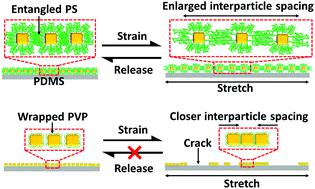当前位置:
X-MOL 学术
›
Nanoscale Horiz.
›
论文详情
Our official English website, www.x-mol.net, welcomes your feedback! (Note: you will need to create a separate account there.)
Plasmene nanosheets as optical skin strain sensors
Nanoscale Horizons ( IF 9.7 ) Pub Date : 2020-08-19 , DOI: 10.1039/d0nh00393j Runfang Fu 1 , Tharindu Warnakula , Qianqian Shi , Lim Wei Yap , Dashen Dong , Yiyi Liu , Malin Premaratne , Wenlong Cheng
Nanoscale Horizons ( IF 9.7 ) Pub Date : 2020-08-19 , DOI: 10.1039/d0nh00393j Runfang Fu 1 , Tharindu Warnakula , Qianqian Shi , Lim Wei Yap , Dashen Dong , Yiyi Liu , Malin Premaratne , Wenlong Cheng
Affiliation

|
Skin-like optoelectronic sensors can have a wide range of technical applications ranging from wearable/implantable biodiagnostics, human–machine interfaces, and soft robotics to artificial intelligence. The previous focus has been on electrical signal transduction, whether resistive, capacitive, or piezoelectric. Here, we report on “optical skin” strain sensors based on elastomer-supported, highly ordered, and closely packed plasmonic nanocrystal arrays (plasmene). Using gold nanocubes (AuNCs) as a model system, we find that the types of polymeric ligands, interparticle spacing, and AuNC sizes play vital roles in strain-induced plasmonic responses. In particular, brush-forming polystyrene (PS) is a “good” ligand for forming elastic plasmenes which display strain-induced blue shift of high-energy plasmonic peaks with high reversibility upon strain release. Further experimental and simulation studies reveal the transition from isotropic uniform plasmon coupling at a non-strained state to anisotropic plasmon coupling at strained states, due to the AuNC alignment perpendicular to the straining direction. The two-term plasmonic ruler model may predict the primary high-energy peak location. Using the relative shift of the averaged high-energy peak to the coupling peak before straining, a plasmene nanosheet may be used as a strain sensor with the sensitivity depending on its internal structures, such as the constituent AuNC size or inter-particle spacing.
中文翻译:

等离子纳米片作为光学皮肤应变传感器
类似于皮肤的光电传感器可以具有广泛的技术应用,从可穿戴/可植入生物诊断,人机界面,软机器人到人工智能。先前的重点是电阻,电容或压电的电信号传导。在这里,我们报告基于弹性体支撑的,高度有序且紧密堆积的等离激元纳米晶体阵列(等离激元)的“光学皮肤”应变传感器。使用金纳米立方体(AuNCs)作为模型系统,我们发现聚合物配体的类型,粒子间的间距和AuNC的尺寸在应变诱导的等离子体反应中起着至关重要的作用。尤其是,形成刷子的聚苯乙烯(PS)是形成弹性等离子体的“良好”配体,该弹性等离子体在应变释放时显示出应变引起的高能等离子体峰的蓝移,并且具有高可逆性。进一步的实验和模拟研究表明,由于AuNC取向垂直于应变方向,因此从非应变状态下的各向同性等离激元耦合转变为应变状态下的各向异性等离激元耦合。两项等离子标尺模型可以预测主要的高能峰位置。利用平均高能峰相对于应变前的耦合峰的相对位移,可以将纤溶质纳米片用作应变传感器,其灵敏度取决于其内部结构,例如构成的AuNC尺寸或粒子间间距。进一步的实验和模拟研究表明,由于AuNC取向垂直于应变方向,因此从非应变状态下的各向同性等离激元耦合转变为应变状态下的各向异性等离激元耦合。两项等离子标尺模型可以预测主要的高能峰位置。利用平均高能峰相对于应变前的耦合峰的相对位移,可以将纤溶质纳米片用作应变传感器,其灵敏度取决于其内部结构,例如构成的AuNC尺寸或粒子间间距。进一步的实验和模拟研究揭示了由于垂直于应变方向的AuNC排列,从非应变状态下的各向同性等离激元耦合转变为应变状态下的各向异性等离激元耦合。两项等离子标尺模型可以预测主要的高能峰位置。利用平均高能峰相对于应变前的耦合峰的相对位移,可以将纤溶质纳米片用作应变传感器,其灵敏度取决于其内部结构,例如构成的AuNC尺寸或粒子间间距。两项等离子标尺模型可以预测主要的高能峰位置。利用平均高能峰相对于应变前的耦合峰的相对位移,可以将纤溶质纳米片用作应变传感器,其灵敏度取决于其内部结构,例如组成的AuNC尺寸或粒子间的间距。两项等离子标尺模型可以预测主要的高能峰位置。利用平均高能峰相对于应变前的耦合峰的相对位移,可以将纤溶质纳米片用作应变传感器,其灵敏度取决于其内部结构,例如构成的AuNC尺寸或粒子间间距。
更新日期:2020-09-08
中文翻译:

等离子纳米片作为光学皮肤应变传感器
类似于皮肤的光电传感器可以具有广泛的技术应用,从可穿戴/可植入生物诊断,人机界面,软机器人到人工智能。先前的重点是电阻,电容或压电的电信号传导。在这里,我们报告基于弹性体支撑的,高度有序且紧密堆积的等离激元纳米晶体阵列(等离激元)的“光学皮肤”应变传感器。使用金纳米立方体(AuNCs)作为模型系统,我们发现聚合物配体的类型,粒子间的间距和AuNC的尺寸在应变诱导的等离子体反应中起着至关重要的作用。尤其是,形成刷子的聚苯乙烯(PS)是形成弹性等离子体的“良好”配体,该弹性等离子体在应变释放时显示出应变引起的高能等离子体峰的蓝移,并且具有高可逆性。进一步的实验和模拟研究表明,由于AuNC取向垂直于应变方向,因此从非应变状态下的各向同性等离激元耦合转变为应变状态下的各向异性等离激元耦合。两项等离子标尺模型可以预测主要的高能峰位置。利用平均高能峰相对于应变前的耦合峰的相对位移,可以将纤溶质纳米片用作应变传感器,其灵敏度取决于其内部结构,例如构成的AuNC尺寸或粒子间间距。进一步的实验和模拟研究表明,由于AuNC取向垂直于应变方向,因此从非应变状态下的各向同性等离激元耦合转变为应变状态下的各向异性等离激元耦合。两项等离子标尺模型可以预测主要的高能峰位置。利用平均高能峰相对于应变前的耦合峰的相对位移,可以将纤溶质纳米片用作应变传感器,其灵敏度取决于其内部结构,例如构成的AuNC尺寸或粒子间间距。进一步的实验和模拟研究揭示了由于垂直于应变方向的AuNC排列,从非应变状态下的各向同性等离激元耦合转变为应变状态下的各向异性等离激元耦合。两项等离子标尺模型可以预测主要的高能峰位置。利用平均高能峰相对于应变前的耦合峰的相对位移,可以将纤溶质纳米片用作应变传感器,其灵敏度取决于其内部结构,例如构成的AuNC尺寸或粒子间间距。两项等离子标尺模型可以预测主要的高能峰位置。利用平均高能峰相对于应变前的耦合峰的相对位移,可以将纤溶质纳米片用作应变传感器,其灵敏度取决于其内部结构,例如组成的AuNC尺寸或粒子间的间距。两项等离子标尺模型可以预测主要的高能峰位置。利用平均高能峰相对于应变前的耦合峰的相对位移,可以将纤溶质纳米片用作应变传感器,其灵敏度取决于其内部结构,例如构成的AuNC尺寸或粒子间间距。



























 京公网安备 11010802027423号
京公网安备 11010802027423号